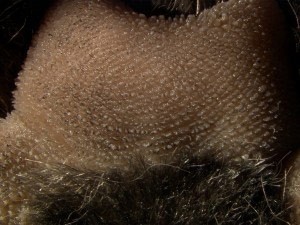
Counting fishers in the rugged terrain of New York’s Adirondack Mountains is tough on scientists – and on the fishers. A new technique, which identifies fishers through prints of their tracks, has the potential to be easier on both the scientists and their subjects.
A fisher, also popularly known as a fisher cat, is not a cat but a large weasel. Each fisher has a five square mile home range in northern coniferous forests and mountainous areas. It’s known for its fierceness and for being one of the few animals that regularly kills and eats porcupines.
Fisher populations have bounced back in the Northeast, after a decline that neared extinction a hundred years ago, but as a top predator, even under the best circumstances, they are relatively rare.
Using traditional census techniques, the fishers would have to be trapped, sedated and tagged, then trapped again. “Trapping and giving them eartags is a lot of work,” says Roland Kays, curator of mammals at the New York State Museum in Albany, NY “Plus, it’s very invasive.”
Instead, Kays checked on the fisher population in the Adirondacks using track plates. Tracking stations were baited with chicken meat. To reach the chicken, any animal had to first step on a soot-coated aluminum plate, then on a piece of white adhesive shelf-paper (think Con-Tact paper).
The footprints obtained from this method are so sharp that not only could the scientists see swirl patterns on each footpad, but also the impressions of the individual wart-like structures that created those patterns, even though each bump was less than one millimeter wide.
It looked to Kays and his team as though the patterns of bumps were distinctive, and were likely unique to individual fishers. If that were true, scientists could identify individual fishers by their unique footprints, much the way fingerprints identify humans. And they would be assured that they were not double counting a repeat visitor.
But how could that idea be tested? It was a task worthy of television’s CSI technicians, who on the show complete such tasks in a montage sequence with upbeat background music. In real life, the job fell to Prescott College master’s degree candidate Carl Herzog who completed the work without the benefit of a montage, although there is no word about the background music.
Herzog first tested severed fisher feet, conveniently immobile, supplied by fur trappers. Then he tested the feet of fishers from the Rosamond Gifford Zoo in Syracuse, New York, which, fortunately, didn’t have to be tracked through miles of forest first. The tests, plus detailed statistical analysis, confirmed that the technique worked.
The next step was to figure out how to compare field-collected footprints easily enough to be practical in a real-life fisher survey. The team tried the software used to analyze human fingerprints, but the software couldn’t make the leap from the ridge patterns of human fingerprints to the dot patterns of the fisher footprints.
However, thanks to advice from fingerprint experts at the New York State Division of Criminal Justice Services, the team learned about poroscopy, an obscure branch of human fingerprint analysis that uses the pores between the ridges – also basically dots – which was helpful in many aspects of the analysis.
While flipping back and forth between two close-up views of an identical area of the track print, the team discovered that different prints of the same foot appeared as if they were rotating slightly as the researcher switched quickly from image to image. Images that were taken from two different animals, meanwhile, just looked like two different images. The researchers found this animation effect helpful in quickly identifying matching footprints. (You can see the effect for yourself on the Web-based program devoted to the fisher finger print technique: www.nysm.nysed.gov/research/biology/fisher/matching_method_introduction.html.)
The proof that fisher prints could be used to identify individuals came too late to play a role in Kays’ most recent Adirondack fisher study, but he plans to use it in his next study, which is not yet scheduled. Meanwhile, another researcher, in Michigan, has already used the technique in a survey of fishers, Kays has learned. The results of that study haven’t been published yet, though.
Kays says the print identification technique might also be applicable to the tracks of other animals. Both primates and koalas are known to have fingerprints, he says, and porcupines have scaly structures on their footpads that might also work with the technique.


Discussion *